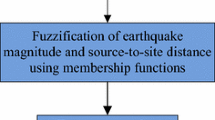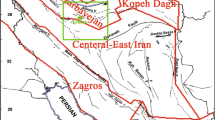Abstract
Producing accurate seismic hazard map and predicting hazardous areas is necessary for risk mitigation strategies. In this paper, a fuzzy logic inference system is utilized to estimate the earthquake potential and seismic zoning of Zagros Orogenic Belt. In addition to the interpretability, fuzzy predictors can capture both nonlinearity and chaotic behavior of data, where the number of data is limited. In this paper, earthquake pattern in the Zagros has been assessed for the intervals of 10 and 50 years using fuzzy rule-based model. The Molchan statistical procedure has been used to show that our forecasting model is reliable. The earthquake hazard maps for this area reveal some remarkable features that cannot be observed on the conventional maps. Regarding our achievements, some areas in the southern (Bandar Abbas), southwestern (Bandar Kangan) and western (Kermanshah) parts of Iran display high earthquake severity even though they are geographically far apart.











Similar content being viewed by others
References
Adriaenssens V, De Baets B, Goethals PLM, De Pauw N (2004) Fuzzy rule-based models for decision support in ecosystem management. Sci Total Environ 319:1–12. doi:10.1016/S0048-9697(03)00433-9
Afshar HK (1960) Report on the Lar earthquake of 24th April 1960. In: Proc. 2nd world conf. earthquake enging, Tokyo, pp 591–607
Allen MB, Saville C, Blanc E, Talebian M, Nissen E (2013) Orogenic plateau growth: expansion of the Turkish-Iranian Plateau across the Zagros fold-and-thrust belt. Tectonics 32(2):171–190. doi:10.1002/tect.20025
Alvarez P, McElwain B, Thesing L, Edalath S, Kukreti A, Cohen K (2014) PD and fuzzy logic control for earthquake resilient structures. Comput Appl Eng Educ 22(1):142–152. doi:10.1002/cae.20540
Ambraseys NN (2001) Reassessment of earthquakes, 1900–1999, in the Eastern Mediterranean and the Middle East. Geophys J Int 145(2):471–485. doi:10.1046/j.0956-540x.2001.01396.x
Ambraseys NN, Melville CP (1982) A history of Persian earthquakes. Cambridge University Press, Cambridge, p 219, ISBN 0 521 24112 X
Andalib A, Zare M, Atry F (2009) A fuzzy expert system for earthquake prediction, case study: the Zagros range. In: 3rd international conference on modeling, simulation, and applied optimization (ICMSAO), American University of Sharjah, Sharjah
Bahroudi A, Talbot CJ (2003) The configuration of the basement beneath the Zagros basin. J Pet Geol 26(3):257–282. doi:10.1111/j.1747-5457.2003.tb00030.x
Baker C, Jackson J, Priestley K (1993) Earthquakes on the Kazerun Line in the Zagros Mountains of Iran: strike-slip faulting within a fold-and-thrust belt. Geophys J Int 115(1):41–61. doi:10.1111/j.1365-246X.1993.tb05587.x
Ben-Zion Y (1996) Stress, slip, and earthquakes in models of complex single-fault systems incorporating brittle and creep deformations. J Geophys Res 101(B3):5677–5706. doi:10.1029/95jb03534
Berberian M (1976) Contribution to the seismotectonics of Iran (Part II). Geological Survey of Iran, Report Number 39, p 516
Berberian M (1995) Master “blind” thrust faults hidden under the Zagros folds: active basement tectonics and surface morphotectonics. Tectonophysics 241(3):193–224. doi:10.1016/0040-1951(94)00185-C
Berberian M, Yeats RS (2001) Contribution of archaeological data to studies of earthquake history in the Iranian Plateau. J Struct Geol 23(2):563–584. doi:10.1016/S0191-8141(00)00115-2
Bilham R (2009) The seismic future of cities. Bull Earthq Eng 7(4):839–887. doi:10.1007/s10518-009-9147-0
de Arcangelis L, Godano C, Grasso JR, Lippiello E (2016) Statistical physics approach to earthquake occurrence and forecasting. Phys Rep 628:1–91. doi:10.1016/j.physrep.2016.03.002
Dewey JW, Grantz A (1973) The Ghir earthquake of April 10, 1972 in the Zagros Mountains of southern Iran: seismotectonic aspects and some results of a field reconnaissance. Bull Seismol Soc Am 63(6–1):2071–2090. doi:10.1130/0016-7606(1973)84<3137:PTATEO>2.0.CO;2
Earthquake Engineering Research Institute (EERI) (2013) The Mw 6.4 Shonbeh (Bushehr), Iran earthquake. http://eeri.org/cohost/Special-EarthquakeReports/M6.4_Iran_Earthquake/index.html
Engdahl ER (2006) Application of an improved algorithm to high precision relocation of ISC test events. Phys Earth Planet Inter 158(1):14–18. doi:10.1016/j.pepi.2006.03.007
Eshghi S, Razzaghi MS (2007) Performance of cylindrical liquid storage tanks in Silakhor, Iran earthquake of March 31, 2006. Bull N Z Soc Earthq Eng 40:4
Finzi Y, Hearn EH, Ben-Zion Y, Lyakhovsky V (2009) Structural properties and deformation patterns of evolving strike-slip faults: numerical simulations incorporating damage rheology. Pure Appl Geophys 166(10–11):1537–1573. doi:10.1007/s00024-009-0522-1
Guclu R, Yazici H (2008) Vibration control of a structure with ATMD against earthquake using fuzzy logic controllers. J Sound Vib 318(1):36–49. doi:10.1016/j.jsv.2008.03.058
Hamzehloo H, Rahimi H, Sarkar I, Mahood M, Alavijeh HM, Farzanegan E (2010) Modeling the strong ground motion and rupture characteristics of the March 31, 2006, Darb-e-Astane earthquake, Iran, using a hybrid of near-field SH-wave and empirical Green’s function method. J Seismol 14(2):169–195. doi:10.1007/s10950-009-9159-x
Hessami KH, Jamali F, Tabassi H (2003) Map of major faults of Iran, scale; 1:2,500,000. International Institute of Earthquake Engineering and Seismology, Tehran
Heyburn R, Selby ND, Fox B (2013) Estimating earthquake source depths by combining surface wave amplitude spectra and teleseismic depth phase observations. Geophys J Int. doi:10.1093/gji/ggt140
ISC (2015) International Seismological Centre, On-line Bulletin. Internatl. Seis. Cent., Thatcham. http://www.isc.ac.uk
Jackson J, Fitch T (1981) Basement faulting and the focal depths of the larger earthquakes in the Zagros Mountains (Iran). Geophys J Int 64(3):561–586. doi:10.1111/j.1365-246X.1981.tb02685.x
Jackson J, McKenzie D (1984) Active tectonics of the Alpine-Himalayan Belt between western Turkey and Pakistan. Geophys J R Astron Soc 77:185–264. doi:10.1111/j.1365-246X.1984.tb01931.x
Jackson J, Haines J, Holt W (1995) The accommodation of Arabia-Eurasia plate convergence in Iran. J Geophys Res 100:15205–15219. doi:10.1029/95JB01294
Juang CH, Elton DJ (1986) Fuzzy logic for estimation of earthquake intensity based on building damage records. Civil Eng Syst 3(4):187–191. doi:10.1080/02630258608970443
Liu Y, Singh C (2011) A methodology for evaluation of hurricane impact on composite power system reliability. IEEE Trans Power Syst 26(1):145–152. doi:10.1109/TPWRS.2010.2050219
Lohman RB, Simons M (2005) Locations of selected small earthquakes in the Zagros Mountains. Geochem Geophys Geosyst 6(3):Q03001. doi:10.1029/2004GC000849
Mamdani EH (1974) Applications of fuzzy algorithm for control a simple dynamic plant. Proc Inst Electr Eng 121(12):1585–1588. doi:10.1049/piee.1974.0328
Moinfar AA (1975) The earthquake of Sarkhun (Bandar-Abbas, Iran) of March 7, 1975, Tehran, Iran, p 29
Molchan GM, Kagan YY (1992) Earthquake prediction and its optimization. J Geophys Res 97:4823–4838
Molinaro M, Guezou JC, Leturmy P, Eshraghi SA, de Lamotte DF (2004) The origin of changes in structural style across the Bandar Abbas syntaxis, SE Zagros (Iran). Mar Pet Geol 21(6):735–752. doi:10.1016/j.marpetgeo.2004.04.001
Mouthereau F, Lacombe O, Vergés J (2012) Building the Zagros collisional orogen: timing, strain distribution and the dynamics of Arabia/Eurasia plate convergence. Tectonophysics 532:27–60. doi:10.1016/j.tecto.2012.01.022
NEIC (2015) National Earthquake Information Center. Earthquake information bulletin Colorado. http://earthquake.usgs.gov/regional/neic/
Oates T, Jensen D (1997) The effects of training set size on decision tree complexity. In: ICML ‘97 proceedings of the fourteenth international conference on machine learning, pp 254–262
Omidvar B, Eskandari M, Peyghaleh E (2013) Seismic damage to urban areas due to failed buried fuel pipelines case study: fire following earthquake in the city of Kermanshah, Iran. Nat Hazards 67(2):169–192. doi:10.1007/s11069-013-0554-9
Ramazi H, Firoozi AA (2013) Seismotectonics and seismicity of the Silakhor region, Iran. J Geol Soc India 82(3):283–289. doi:10.1007/s12594-013-0151-2
Ramazi H, Hosseinnejad M (2009) The Silakhor (Iran) earthquake of 31 March 2006, from an engineering and seismological point of view. Seismol Res Lett 80(2):224–232. doi:10.1785/gssrl.80.2.224
Ramsey LA, Walker RT, Jackson J (2008) Fold evolution and drainage development in the Zagros Mountains of Fars province, SE Iran. Basin Res 20(1):23–48. doi:10.1111/j.1365-2117.2007.00342.x
Regard V, Bellier O, Thomas JC, Abbassi MR, Mercier J, Shabanian E, Soleymani S (2004) Accommodation of Arabia-Eurasia convergence in the Zagros-Makran transfer zone, SE Iran: a transition between collision and subduction through a young deforming system. Tectonics 23:4. doi:10.1029/2003TC001599
Şen Z (2010) Rapid visual earthquake hazard evaluation of existing buildings by fuzzy logic modeling. Expert Syst Appl 37(8):5653–5660. doi:10.1016/j.eswa.2010.02.046
Sepehr M, Cosgrove JW (2005) Role of the Kazerun Fault Zone in the formation and deformation of the Zagros Fold-Thrust Belt, Iran. Tectonics 24:5. doi:10.1029/2004TC001725
Sepehr M, Cosgrove JW (2007) The role of major fault zones in controlling the geometry and spatial organization of structures in the Zagros Fold-Thrust Belt. Geol Soc Lond Spec Publ 272(1):419–436. doi:10.1144/GSL.SP.2007.272.01.21
Stampfli GM, Borel GD (2002) A plate tectonic model for the Paleozoic and Mesozoic constrained by dynamic plate boundaries and restored synthetic oceanic isochrons. Earth Planet Sci Lett 196(1):17–33. doi:10.1016/S0012-821X(01)00588-X
Takagi T, Sugeno M (1985) Fuzzy identification of systems and its applications to modeling and control systems. IEEE Trans Syst Man Cybern SMC-15(1):116–132. doi:10.1109/TSMC.1985.6313399
Talebian M, Jackson J (2004) A reappraisal of earthquake focal mechanisms and active shortening in the Zagros Mountains of Iran. Geophys J Int 156:506–526. doi:10.1111/j.1365-246X.2004.02092.x
Tatar M, Hatzfeld D, Ghafori-Ashtiany M (2004) Tectonics of the Central Zagros (Iran) deduced from microearthquakes seismicity. Geophys J Int 156:255–266. doi:10.1111/j.1365-246X.2003.02145.x
Tavakoli F, Walpersdorf A, Authemayou C, Nankali HR, Hatzfeld D, Tatar M, Cotte N (2008) Distribution of the right-lateral strike–slip motion from the Main Recent Fault to the Kazerun Fault System (Zagros, Iran): evidence from present-day GPS velocities. Earth Planet Sci Lett 275(3):342–347. doi:10.1016/j.epsl.2008.08.030
Tchalenko JS, Braud J (1974) Seismicity and structure of the Zagros (Iran): the Main Recent Fault between 33 and 35 N. Philos Trans R Soc Lond Ser A Math Phys Sci. doi:10.1098/rsta.1974.0044
Tesfamariam S, Saatcioglu M (2010) Seismic vulnerability assessment of reinforced concrete buildings using hierarchical fuzzy rule base modeling. Earthq Spectra 26(1):235–256. doi:10.1193/1.3280115
Tikk D, Csaba Johanyák Z, Kovács S, Wong KW (2011) Fuzzy rule interpolation and extrapolation techniques: criteria and evaluation guidelines. J Adv Comput Intell Intell Inform 15(3):254–263. doi:10.20965/jaciii.2011.p0254
Tsukamoto Y (1979) Advances in fuzzy set theory and applications, chapter: an approach to fuzzy reasoning method. North-Holland, Amsterdam, pp 137–149
Vergés J, Saura E, Casciello E, Fernàndez M, Villaseñor A, Jiménez-Munt I, Garcia-Castellanos D (2011) Crustal-scale cross-sections across the NW Zagros belt: implications for the Arabian margin reconstruction. Geol Mag 148(5–6):739–761. doi:10.1017/S0016756811000331
Walker RT, Bergman E, Jackson J, Ghorashi M, Talebian M (2005) The 2002 June 22 Changureh (Avaj) earthquake in Qazvin province, northwest Iran: epicentral relocation, source parameters, surface deformation and geomorphology. Geophys J Int 160(2):707–720. doi:10.1111/j.1365-246X.2005.02516.x
Wiemer S (2001) A software package to analyze seismicity: ZMAP. Seismol Res Lett 72:374–383. doi:10.1785/gssrl.72.3.373
Wiemer S, Wyss M (2000) Minimum magnitude of complete reporting in earthquake catalogs: examples from alaska, the western united states, and japan. Bull Seismol Soc Am 90:859–869. doi:10.1785/0119990114
Woessner J, Wiemer S (2005) Assessing the quality of earthquake catalogues: estimating the magnitude of completeness and its uncertainty. Bull Seismol Soc Am. doi:10.1785/0120040007
Yamini-Fard F, Hatzfeld D, Tatar M, Mokhtari M (2006) Microearthquake seismicity at the intersection between the Kazerun fault and the Main Recent Fault (Zagros, Iran). Geophys J Int 166(1):186–196. doi:10.1111/j.1365-246X.2006.02891.x
Zadeh LA (1965) Fuzzy sets. Inf Control 8:338–353. doi:10.1016/S0019-9958(65)90241-X
Zadeh LA (1973) Outline of a new approach to the analysis of complex systems and decision processes. IEEE Trans Syst Man Cybern 1:28–44. doi:10.1109/TSMC.1973.5408575
Zamani A, Agh-Atabai M (2009) Temporal characteristics of seismicity in the Alborz and Zagros regions of Iran, using a multifractal approach. J Geodyn 47(5):271–279. doi:10.1016/j.jog.2009.01.003
Zamani A, Sami A, Khalili M (2012) Multivariate rule-based seismicity map of Iran: a data-driven model. Bull Earthq Eng 10(6):1667–1683. doi:10.1007/s10518-012-9386-3
Zamani A, Sorbi MR, Safavi AA (2013) Application of neural network and ANFIS model for earthquake occurrence in Iran. Earth Sci Inf 6(2):71–85. doi:10.1007/s12145-013-0112-8
Zamani A, Kolahi Azar AP, Safavi AA (2014) Wavelet-based multifractal analysis of earthquakes temporal distribution in Mammoth Mountain volcano, Mono County, Eastern California. Acta Geophys 62(3):585–607. doi:10.2478/s11600-013-0184-3
Zamani A, Farahi S, Boostani R, Hassani-Saadi H (2015) Geoenvironmental zoning evaluation and optimization. Earth Sci Inf 8(3):583–593. doi:10.1007/s12145-014-01840
Zechar JD (2010) Evaluating earthquake predictions and earthquake forecasts: a guide for students and new researchers. doi:10.5078/corssa-77337879. http://www.corssa.org
Zhang Y, Oldenburg CM, Finsterle S (2010) Percolation-theory and fuzzy rule-based probability estimation of fault leakage at geologic carbon sequestration sites. Environ Earth Sci 59:1447–1459. doi:10.1007/s12665-009-0131-4
Zhou SM, Gan JQ (2008) Low-level interpretability and high-level interpretability: a unified view of data-driven interpretable fuzzy system modelling. Fuzzy Sets Syst 159(23):3091–3131. doi:10.1016/j.fss.2008.05.016
Acknowledgements
This work was supported by the Iranian National Institute for Oceanography and Atmospheric Science and Center of Excellence for Environmental Geo-hazards, and the Research Council of Shiraz University.
Author information
Authors and Affiliations
Corresponding author
Rights and permissions
About this article
Cite this article
Farahi Ghasre Aboonasr, S., Zamani, A., Razavipour, F. et al. Earthquake hazard assessment in the Zagros Orogenic Belt of Iran using a fuzzy rule-based model. Acta Geophys. 65, 589–605 (2017). https://doi.org/10.1007/s11600-017-0055-4
Received:
Accepted:
Published:
Issue Date:
DOI: https://doi.org/10.1007/s11600-017-0055-4





